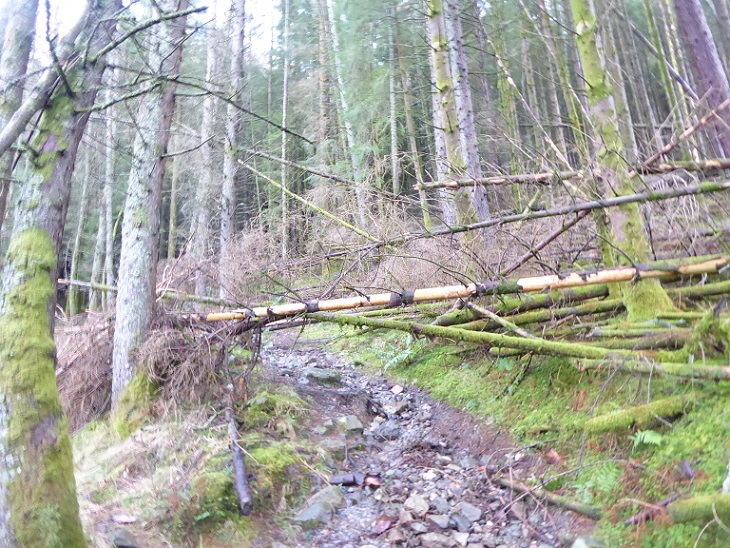 On Monday I went for a wander around Glen Ample from Loch Lubnaig in Strathyre, starting at the car park used by hillwalkers for the popular round of Stuc a Chroin and Beinn Each. I had not walked the first part of the route, between Ardchullarie and the Ardchullarie hydro (see here), for many years. It provides a perfect illustration of the Loch Lomond and Trossachs National Park Authority (LLTNPA)’s many shortcomings, including its statutory duty to promote public enjoyment of the countryside.
On Monday I went for a wander around Glen Ample from Loch Lubnaig in Strathyre, starting at the car park used by hillwalkers for the popular round of Stuc a Chroin and Beinn Each. I had not walked the first part of the route, between Ardchullarie and the Ardchullarie hydro (see here), for many years. It provides a perfect illustration of the Loch Lomond and Trossachs National Park Authority (LLTNPA)’s many shortcomings, including its statutory duty to promote public enjoyment of the countryside.
The blocked path
A few hundred metres along wind thrown trees had fallen across the path in several places. By all appearances some of them had been there for several years.
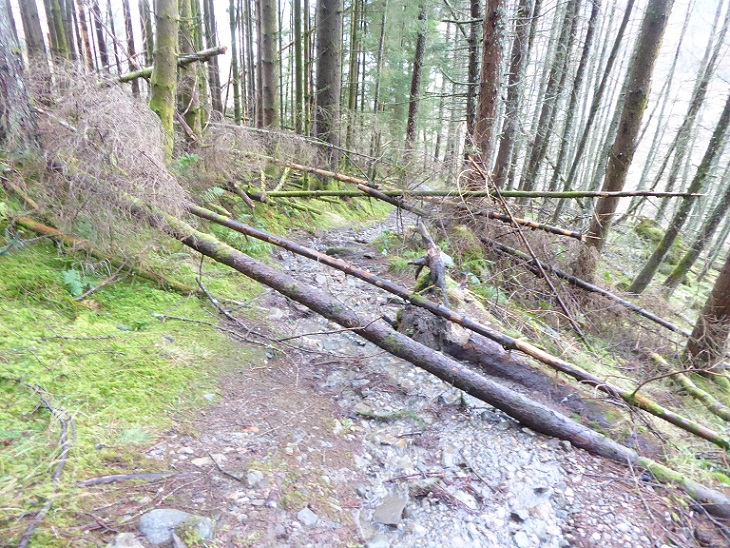 For most hill walkers such blockages are no problem, which is possibly why the LLTNPA hasn’t been deluged with complaints. But the path over the watershed into Glen Ample is also a historic right of way, which is likely to attract people less experienced, able or willing to clamber, and is one of the LLTNPA’s designated core paths.
For most hill walkers such blockages are no problem, which is possibly why the LLTNPA hasn’t been deluged with complaints. But the path over the watershed into Glen Ample is also a historic right of way, which is likely to attract people less experienced, able or willing to clamber, and is one of the LLTNPA’s designated core paths.
Under Section 19 of the Land Reform Scotland Act 2003 core paths have special status and access authorities “may do anything which they consider appropriate for the purposes of—
(a) maintaining a core path;
(b) keeping a core path free from obstruction or encroachment;
(c) providing the public with directions to, or with an indication of the extent of, a core path.”
This section of core path is just five minutes walk from the road. If there was the will, it would be easy enough for one of the LLTNPA’s team of rangers to clear the obstructions with a chainsaw.
The lack of maintenance
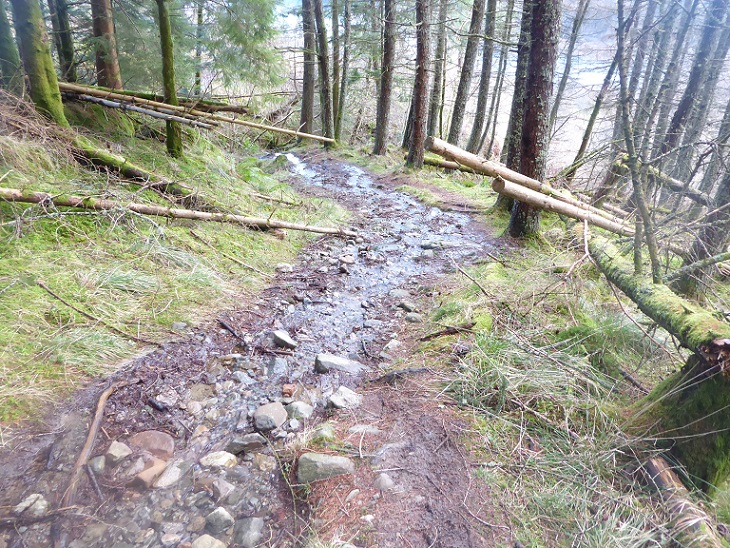
Much of the core path/right of way is now a burn and is as a result eroding badly.
Apologies for the out of focus photo but it illustrates the issues:
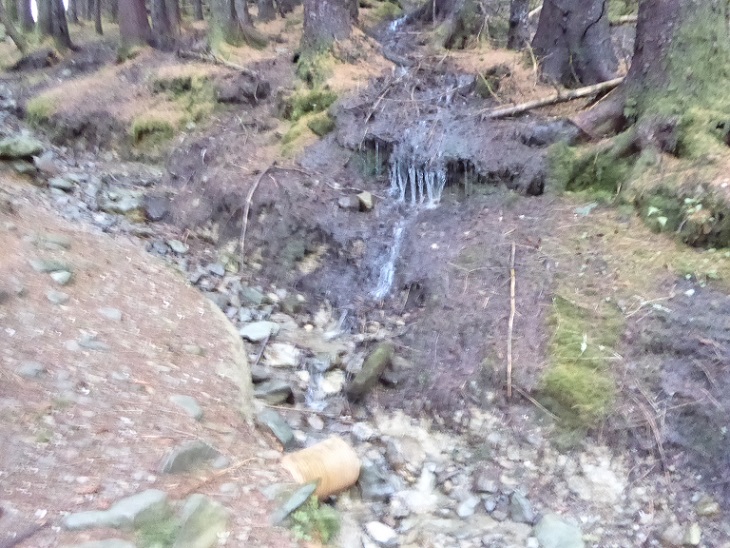
Past investment in this path, aimed at preventing erosion, has all been allowed to go to waste through lack of maintainance. The LLTNPA has long invested NOTHING in the maintenance of its core path network and has no plans to ensure its core path network is in a fit state for use by the general public (including those with disabilities).
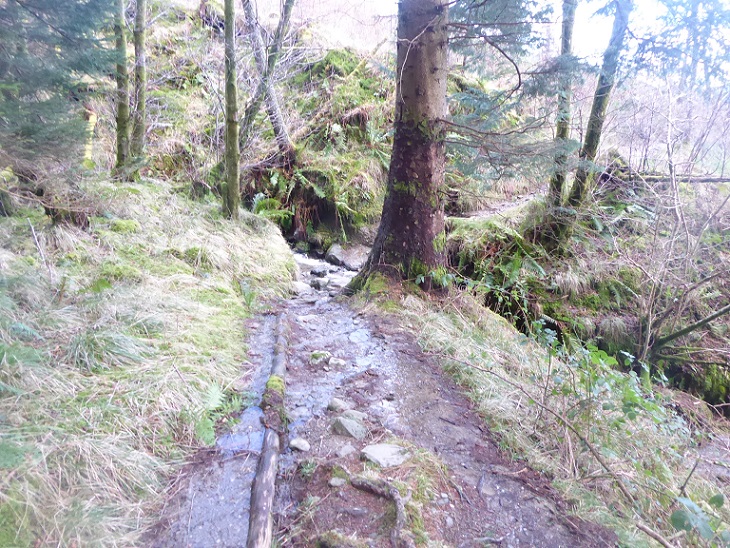
The LLTNPA has simply abandoned its responsibilities when it could have been using its rangers to prevent small path problems developing into large ones that will cost tens of thousands of pounds to fix.
Health and safety
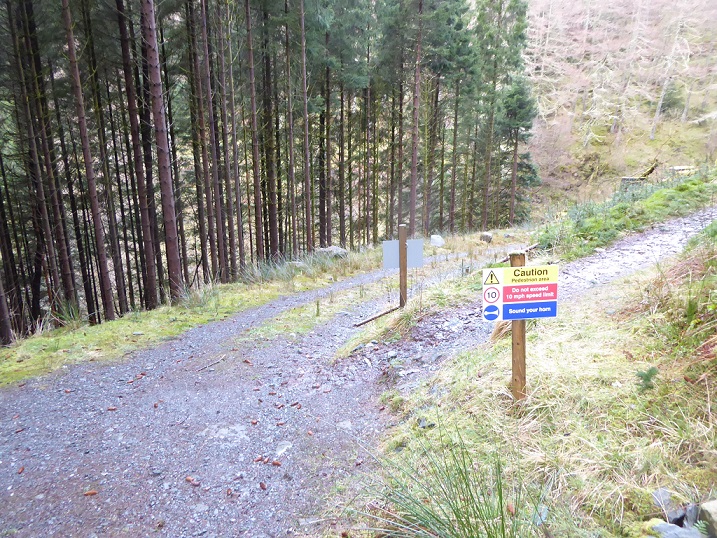
At the top of this section of path it crosses the access track to the Ardchullarie hydro intake. After crossing the various hazards posed by fallen trees, the walker passes two health and safety signs which advisers drivers to sound their horn at the very point their vehicle would be crossing the path! A ranger service which was on the ground, knew its patch and was infused with the values of access rights could help prevent such stupidities but not in this National Park.
Undermining access rights
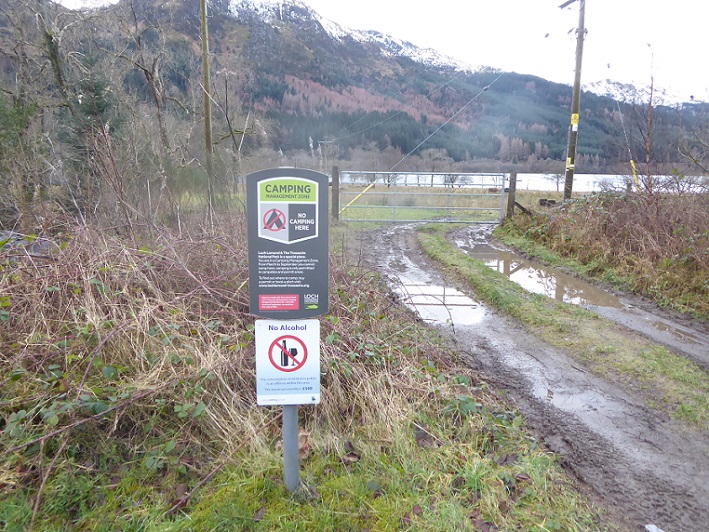 Instead the LLTNPA Ranger Service – the largest in Scotland – has for the last seven years devoted most of efforts towards enforcing the camping byelaws. Just below the start of the Ardchullarie core path, on the other side of the A84, there was one of the Camping Management Zone “no camping” signs. Rangers must pass this sign on a daily basis over the summer months and no doubt stop off in the layby to check the field for tents, while having no time to walk the path above.
Instead the LLTNPA Ranger Service – the largest in Scotland – has for the last seven years devoted most of efforts towards enforcing the camping byelaws. Just below the start of the Ardchullarie core path, on the other side of the A84, there was one of the Camping Management Zone “no camping” signs. Rangers must pass this sign on a daily basis over the summer months and no doubt stop off in the layby to check the field for tents, while having no time to walk the path above.
The message given by this sign is no camping, full stop. You cannot read the small print from a car and few pedestrians are likely to cross the road to do so. It says “From March to September you cannot camp here, camping is only permitted in campsites and permit areas”. There is no indication on the sign that people might be welcome to camp the other five months of the year. The sign, as worded, therefore acts as a deterrent to people wanting to exercise what remains of their lawful right to camp. It should therefore be removed outwith the camping byelaw “season”. That won’t happen, however, while the LLTNPA as Access Authority acts as judge and jury of its own actions.
Planning and access rights
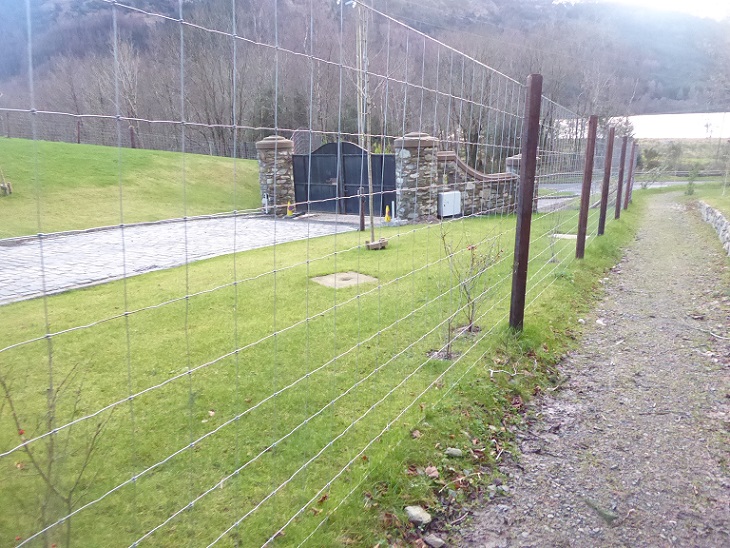
The buildings at Ardchullarie are in the process of being converted into an exclusive private residence. There are serious questions about whether landscaping like this – the gates, the large areas of lawn and imported cobbles – are appropriate in a National Park. But here I wish to consider the new deer fence which extends up the hillside to where the path enters the conifer plantation.  Access rights don’t cover the curtilage of buildings or gardens, so whatever one thinks of the design of the development, the lower section of fence is not unreasonable. However, the fence does not just serve to exclude people from the garden, it blocks access to the hillside above:
Access rights don’t cover the curtilage of buildings or gardens, so whatever one thinks of the design of the development, the lower section of fence is not unreasonable. However, the fence does not just serve to exclude people from the garden, it blocks access to the hillside above:
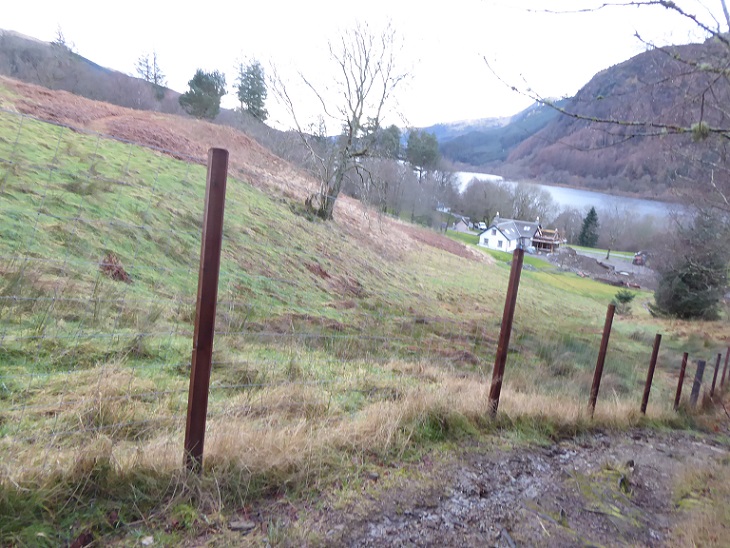 There are no gates through the fence and, while the owners of the property may wish to exclude deer from it, they have no right to exclude people from the entire area. Yet the LLTNPA’s planners have allowed this to happen. On this, they have had form, ever since they allowed their then Convener Linda McKay, since 2014 a non-executive director of the Scottish Government and now an MBE, to take over part of the shoreline at Loch Venachar (see here).
There are no gates through the fence and, while the owners of the property may wish to exclude deer from it, they have no right to exclude people from the entire area. Yet the LLTNPA’s planners have allowed this to happen. On this, they have had form, ever since they allowed their then Convener Linda McKay, since 2014 a non-executive director of the Scottish Government and now an MBE, to take over part of the shoreline at Loch Venachar (see here).
What needs to happen
Signs, fences, obstructions to access and a failure to maintain the path network, most of the failings of the LLTNPA in respect to outdoor recreation encapsulated in an 800m walk. The new Green Minister responsible for National Parks, Lorna Slater, might usefully consider taking a visit before the LLTNPA Board considers their so far vacuous and much delayed outdoor recreation plan next month (see here).
That plan should form the basis of the LLTNPA adopting a totally new approach to access and outdoor recreation: one which puts respect for access rights at the centre of everything the National Park does, invests resources into infrastructure that supports people’s ability to enjoy the countryside, including the path network, and re-designs the ranger service to support these objectives. We will see!
It’s hard to believe that the authors of the Act were unaware of how the wording “may do” would be interpreted by the bodies to which it was addressed. Look at any legislation applied to such bodies in the expectation of compliance; it states explicitly what they MUST do, in what timescale and what the penalties are for failing to comply.
Are any LLTPA Rangers even qualified and trained to do such work?
Hello Nick
Thanks for posting this. There is clear guidance on fencing but who enforces this when landowners don’t put gates in or padlock them shut? There is an estate near me, in East Lothian, that has 5 gates in a new “conservation” fence which is conveniently around their Big House! All gates are padlocked. They never applied for an exclusion zone like Anne Gloag at Kinfauns Castle or the Queen at Balmoral but this now means that they have a very large “private” garden (180ha if I remember correctly).
It didn’t take long for the judges to water down the Act with case law that effectively states that the amount of “privacy” you are entitled to depends on how rich you are and access authorities are well aware of this.
Nick. Some Apologies for parallel thoughts. I feel There is something fundamentally wrong with teaching in Scotland now. A whole generation has grown up, many now parents or teachers themselves , while allowed to think they have ‘rights’ but no one can force them into accepting responsibilities.
I am not sure where the “cancer” first started, but the inability to be part of a team; to volunteer to help run social projects unpaid; to take part in local councils and wider discussions that will lead to improvements for the way things are run, seems to be universal and growing. Life today is all about “me” .
There seems to be an aspect of hopelessness in the face of overbearing and too often unaccountable ‘Quangos’. People feel unwilling to risk being ridiculed locally or criticised for their viewpoints. Meanwhile those who climb the greasy ladder – to gain access to positions of influence – seem happy to leave social responsibility on the bottom rungs, and then hide behind faceless committees.
Whatever was so wrong with ” Do as you would be done by” ? It is really the case today that this ‘parable of the human condition’ – the historical ‘Golden Rule’ – is no longer Politically correct enough to be aired in Scotland’s schools? If so, why ?